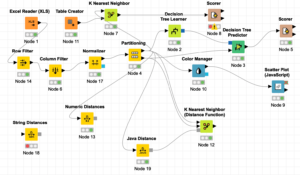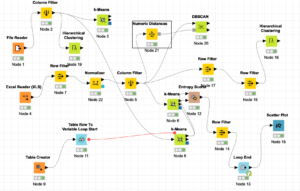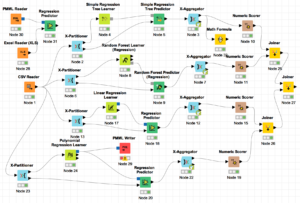You can find the course content for End to End Data Science Practicum with Knime in Udemy. You can also get registered to the course with below discount coupon:
https://www.udemy.com/datascience-knime/?couponCode=KNIME_DATASCIENCE
- Introduction to Course
- What is this course about?
- How are we going to cover the content?
- Which tool are we going to use?
- What is unique about the course?
- What is Data Science Project and our methodology
- Project Management Techniques
- KDD
- CRISP-DM
- Working environment and Knime
- Installation of Knime
- Versioning of Knime
- Resources (Documentation, Forums and extra resources)
- Welcome Screen and working environment of Knime
- Welcome to Data Science
- Understanding of a workflow
- First end-to-end problem: Teaching to the machine
- First end-to-end workflow in Knime
- Understanding Problem
- Types of analytics
- Descriptive Analytics and some classical problems
- Predictive Analytics
- Prescriptive Analytics
- Understanding Data
- File Types
- Coloring Data
- Scatter Matrix
- Visualization and Histograms
- Data Preprocessing (Excel Files : cscon_gender , cscon_age)
- Row Filtering
- Rule Based Row Filtering
- Column Filtering
- Group by , Aggregate
- Join and Concatenation
- Missing Values and Imputation
- Date and Time operations
- Example 1
- Feature Engineering
- Encoding: One – To – Many
- Rule Engine
- Imbalanced Data: SubSampling, SMOTE
- Models
- Introduction to Machine Learning : Test and Train Datasets
- Introduction to Machine Learning: Problem Types
- Classification Problems (Excel Files : cscon_gender )
- Naive Bayes and Bayes Theorem
- Binning and Naive Bayes practicum (click to download the workflow)
- Decision Tree
- Decision Tree Practicum (. Click here to download the workflow )
- K-Nearest Neighborhood
- KNN Practicum (click to download the workflow)
- Distance Metrics of KNN
- Distance Metrics Practicum (click here to download the knime workflow)
- Support Vector Machines
- Kernel Trick and SVM Kernels
- SVM Practicum
- End to End Practicum for Classification
- Extra: Logistic Regression
- Extra: Logistic Regression Practicum
- ARM Problems
- Clustering Problems
- Regression Problems
- Knime as a tool : Some Advanced Operations
- Evaluation
- Introduction to Evaluation
- ZeroR Algorithm, Imbalanced Data Set and Baseline
- k-fold Cross Validation
- Confusion Matrix, Precision, Recall, Sensitivity, Specificity
- Evaluation of clustering: purity , randindex
- Evaluation of prediction: rmse, rmae, mse, mae
- Evaluation Practicum with knime: Example 3
- Evaluation of ARM
- Introduction to Evaluation
- Reporting
- Exporting Reports to Images (Data to Report)
- Connecting Knime with other Languages
- Java Snippet
- R Snippet
- Python Snippet
- Meta Learners
- Ensemble Techniques: Bagging, Boosting and Fusion
- Random Forest ensemble learning technique for Classification
- Random Forest ensemble learning technique for Regression
- Random Forest Practicum
- Gradient Boosted Tree Regression
- Gradient Boosted Tree Regression Practicum
- Example 4
- Deep Learning
- Introduction to artificial neural networks
- Linearly Separable Problems and beyond
- DL4J Extension
- Real Life Practicums
- Resources about real life applications : Job Search, Forums, Competitions etc.
- Predicting the customer will pay or not
- Predicting the period of payments
- Credit Limit
- Customer Segmentation
- Bonus
- Loading different train and test datasets
- Data Preprocessing Practicum(Click to download knime file)
- Regression Practicum (Simple Linear, Multiple Linear Regression, Correlation Matrix, p-Value and Feature Elimination (backward Elimination, Forward Selection) )Knime Files: File 1, File 2
- Comparing the Regression Models : Decision Tree Regression, Random Forest Regression, Linear Regression, Polynomial Regression (Click to Download the Knime File)
- Evaluation of Regression Models (R2 and adjusted R2 ), Introduction to Classification problems and Logistic Regression
- Logistic Regression and Introduction to Classification (Click to Download the Knime File)
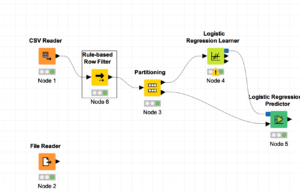
- Time Series Analysis and Classification algorithms : Decision Tree, Random Forest
- Temporal Feature Extraction (Data and Time) (Click to Download Knime File) (sample CSV file: )
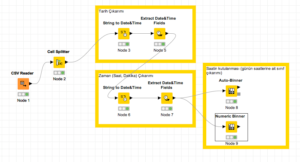
- Time Series Analysis and an example of Moving Average: (Click to Download Knime File)

- Titanic Data Set (CSV)
- Classification Example (Click to Download Knime File)

- Imbalanced Datasets
- Unbalanaced Data Sets and Solutions: Under-sampling, SMOTE (Click to Download Knime File)
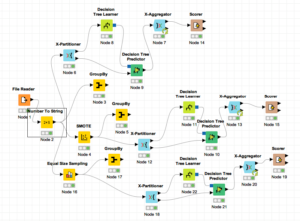
- External Links
- Customer Segmentation and Python ( Click to Download Knime File , Click to Download Dataset)
- Comparison of Clustering Algorithms: K-Means, K-Medoids ve Hierarchical Clustering (HC) and finding optimum Number of clusters with WCSS for K-Means ( cluster distance functions min, Max, group average, center, ward’s method) : Click to download knime file
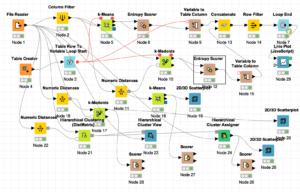
- Steps for above workflow
- 1. Load Iris dataset
1.1. Filter the class column
2. For K-Means and K-Medoids
2.1. Find the best cluster number
2.2. Cluster with K-means and K-medoids
3. Find the best K value for Hierarchical Clustering(HC)
4. Cluster with HC
5. Cluster with K=3
6. Compare your results with K=3
7. Report the best clustering - Evaluations:HC : 24 Error
KMeans : 17 error
KMedoids : 16 error
- Text Mining.
- Click to download the sample text file
- RSS Workflow (Required Extension: Palladian and Text Processing)
- Text Tagging and Tag Clud: Click to Download Knime Workflow


- Text Classification Click to download Knime Workflow




